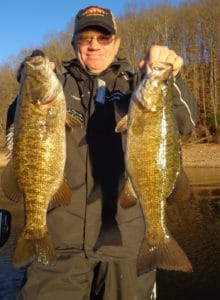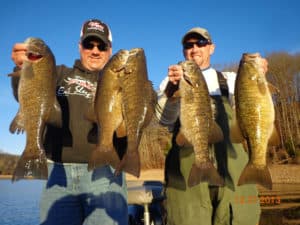by Beau Tallent
Smallmouth bass may be the hardest-hitting, strongest-fighting, highest-jumping freshwater fish anglers have the pleasure of targeting.

Smallmouth bass grow huge on Mid-South reservoirs like Wilson, Pickwick and Tim’s Ford. Here, guide Jake Davis shows off a pair of 4 1/2-pound bronze beauties.
And make no mistake, in waters where smallmouth are present, this species is sought with a passion.
While primarily thought of as a northern species, smallmouth bass inhabit some southern waters where the weather is more tolerable for wintertime fishing, and it just so happens these southern waters are where some of the biggest smallmouth grow and the best fishing for numbers of smallmouth exists in the world.
North Alabama and the southern section of middle Tennessee are where anglers should turn their attention to cure smallmouth cabin fever. In this region, winter is the time of year a lot of smallmouth bass fisherman look forward to each year. Mid-South lakes such as Pickwick, Tim’s Ford and Wilson are some of the best in the nation for winter and early spring fishing. Now is when these lakes are on fire for smallmouth bass.
Capt. Jake Davis, a fishing guide who specializes on Tennessee River reservoirs and other lakes in this region, said, “The best times are over the next couple of months, when the air temps are cold and the water temps reach that magical 48- to 53-degree range. This may sound like a cold time of the year, and it is, but to a smallmouth bass angler, it means that some of the hottest fishing of the year is here.”
Smallmouth, unlike largemouth bass, will remain active in the cooler water.
“Smallmouth in the deeper, clear lakes will start to school up on main-lake structure and points,” Capt. Davis said. “Areas like steep sloping points, deep chunk-rock banks with transition areas to gravel, underwater humps and where two or more creek channels meet are prime areas for smallmouth.”
As for bait choices, Capt. Davis said to use the water temps as a guide.
“When the water temperatures range from 56 to 64, you can throw topwater baits, jigs, spinnerbaits and start testing crankbaits. Topwater lures such as Pop-Rs can produce some explosive topwater strikes. If the water cools down, the crankbait action will really heat up. Also, this whole time you can also use jigs, tubes, or live bait like shiners or chubs if you prefer.”
Here is some advice from more of the area’s top professional fishing guides as you plan a trip to the chase giant smallmouth in the Mid-South region.
Capt. Brent Crow, a guide and tournament pro, suggests the best time to fish Wilson Lake is early spring from March until May. Smallmouths begin moving up when the water temps reach 55 degrees. As for Pickwick, Capt. Crow recommends late fall and early winter and again in March through May as well. The big pre-spawn females weigh the most in March, and they are ready to battle after the winter. Brent’s favorite smallmouth lake is Pickwick. He said there are so many 4- to 6-lb. smallmouth bass in the lake right now. His best trip this past year saw clients catch 18 fish over 4 pounds and four over 6 pounds.
Nothing beats a swimbait for big smallmouths. Brent uses a 5.5-inch Strike King Shadalicious Swimbait on a ½-ounce Squadron jig head on 20-lb. fluorocarbon more than any other setup. A ¾-oz. football jig with a Strike King Rage Craw trailer is also a great choice for big smallmouth if they won’t chase the swimbait.
Capt. Ryan Salzman, with Alabama Bass Guides, pursues smallmouth on Wilson Lake from February through May and again during October through December. Targeting smallmouth during these seasons means targeting main-lake points on the lower end of the lake, and fishing in the tailwaters below Wheeler Dam. Late fall offers great topwater action with a Zara Spook in the tailwaters. His preferred lures are single swimbaits, Rapala DT20 crankbaits, Alabama Rig, jerkbaits, ¼-oz. watermelon red grub, and 3/4- to 3/8-oz. double willowleaf spinnerbait. Pickwick Lake is Salzman’s preferred smallmouth lake during the early spring because of the numbers of great big giant smallmouth that live in the tailrace below Wilson Lake. When they move up in the current to begin feeding for the spawn, his clients regularly catch five-fish limits weighing more than 20 pounds consisting of giant smallmouth bass.

This region produces not just big smallmouth or great numbers during the winter, it produces both! This five-bass limit of smallmouths weighed more than 22 pounds.
Your best odds of catching a 5-lb. or better smallmouth is during March and April. You can catch smallmouth throughout the year; however, this is when you will likely catch your personal best. The smallmouth are fat and healthy from feeding during the pre-spawn, and they are the heaviest they will be all year.
Capt. Davis said, “Tim’s Ford Lake is my preferred smallmouth lake in the South. The best times to catch smallmouth are early October through late May. I use a lot of light-line tactics such as Spot Removers with grubs and downsized swimbaits. In late winter and early spring, it is deep cranking and ½-oz. Tight Line football head jigs. As the spawn starts, it is hard to beat a Carolina- or Texas-rigged D-Bomb from Missile Baits.
Here are some helpful hints for catching southern smallmouth from these top guides:
Locating smallmouth: Fishing breaks in the current is always a good idea, and it is especially true during the winter. In the cold, bass need to conserve energy to survive the difficult conditions. This will cause smallmouth to stay out of the current behind rocks and logs and in wider areas of the river where the current is slower. Any area that is receiving sunlight on cold days is likely to hold bass, as well. Banks which descend at 45 degrees are great places to start.
Watch the Weather: “I’m a firm believer that anytime on the water is a good time,” said Capt. Davis. “If your time is limited, then plan your trips around weather changes. The best days might be any unseasonably warm day during the winter, but fishing before a cold front or any other weather change can also be productive.”
Lure Selection: In general, when pursuing smallmouth, you should use variety of different lures until you establish a pattern and it can change daily. Fish your baits in 5 to 30 feet of water.
Stay Out of Sight: Winter water is often crystal clear. It is important to take steps to stay out of sight of the smallmouth bass in this clear water. When fishing from the bank, stay back from the water as far as possible and avoid casting your shadow over the water. When boat fishing, slowly approach areas where you want to fish, and use your boat’s motor sparingly. Use the lightest practical line on your reel, as the line will be more visible to the fish in the clear water. Do not wear brightly colored clothing such as hunter orange or white.
Safety and Comfort: You should avoid fishing solo in cold weather. A fall into freezing water can be deadly. In addition to having someone along to help out in case of an emergency, you should dress well to protect against the cold. Place a change of clothes in the vehicle. Always, let someone know what areas of the lake you’ll be fishing and the expected time of your return home.
For more information on southern smallmouth bass, contact Capt. Jake Davis www.midsouthbassguide.com, Capt. Brent Crow http://www.northalabamabass.com or Capt. Ryan Salzman http://www.alabamabassguide.com.
The Union Sportsmen’s Alliance website is designed to provide valuable articles about hunting, fishing and conservation for members of AFL-CIO affiliated labor unions and all sportsmen and sportswomen who appreciate hunting and fishing and want to preserve our outdoor heritage for future generations. If you would like your own story and experience from the outdoors to be considered for our website, please email us at [email protected].




